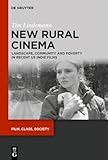New Rural Cinema : Landscape, Community and Poverty in Recent US Indie Films / Tim Lindemann.
Material type: TextSeries: Film, Class, Society ; 2Publisher: Berlin ; Boston : De Gruyter, [2024]Copyright date: 2024Description: 1 online resource (VII, 237 p.)Content type:
TextSeries: Film, Class, Society ; 2Publisher: Berlin ; Boston : De Gruyter, [2024]Copyright date: 2024Description: 1 online resource (VII, 237 p.)Content type: - 9783110779233
- 9783110779431
- 9783110779417
- 791.43/6526942 23/eng/20240404
- PN1995.9.P63 L56 2024
- online - DeGruyter
- Issued also in print.
| Item type | Current library | Call number | URL | Status | Notes | Barcode | |
|---|---|---|---|---|---|---|---|
 eBook
eBook
|
Biblioteca "Angelicum" Pont. Univ. S.Tommaso d'Aquino Nuvola online | online - DeGruyter (Browse shelf(Opens below)) | Online access | Not for loan (Accesso limitato) | Accesso per gli utenti autorizzati / Access for authorized users | (dgr)9783110779417 |
PhD Queen Mary, London 2022.
Frontmatter -- Acknowledgements -- Contents -- Introduction -- Chapter One Against the “Propertied Gaze” – Rural Poverty in the United States and its Cinematic Representations -- Chapter Two From Landschaft to Landscape: Perspectives and Transformations in Geography and the Cinema -- Chapter Three Wild Country – National Identity and Landscape in the United States -- Chapter Four Disrupted Geography and the Criminal Margins – Winter’s Bone (2010) -- Chapter Five The Wilderness Illusion – Leave No Trace (2018) -- Chapter Six Landscapes in Terminal Crisis: Beasts of the Southern Wild (2012) -- Chapter Seven Vestiges of Oppression: Ballast (2008) -- Conclusion Towards a “Landscape Consciousness”? -- Bibliography -- Selected Filmography — New Rural Cinema -- General Filmography -- Index
restricted access online access with authorization star
http://purl.org/coar/access_right/c_16ec
In the past decade, spanning from the aftermath of the 2008 financial crisis to the beginning of the Covid-19 pandemic, rural poverty in the United States has risen dramatically. The impact of the pandemic is set to intensify these inequalities as the decades of neoliberal dismantling of public healthcare and other social institutions leave inhabitants of impoverished rural areas particularly vulnerable.Even before this current exacerbation, representations of rural landscape in American cinema have sought to spatially visualize the country’s social inequalities and focus on the victims of poverty and marginalization. The films discussed in this monograph, Ballast (2008), Winter’s Bone (2010), Beasts of the Southern Wild (2012), and Leave No Trace (2018), address deep rural poverty in a complex manner and facilitate an interactive, social understanding of landscape.New Rural Cinema suggest a novel way of looking at landscape in cinema that responds to and guides its readers through this recent development in American Independent film. It views the chosen films as expressions of a growing awareness of the dire inequality caused by neoliberal capitalism in the United States and the role landscape plays both in its mechanisms of social exclusion as well as in its collective contestation.
Issued also in print.
Mode of access: Internet via World Wide Web.
In English.
Description based on online resource; title from PDF title page (publisher's Web site, viewed 20. Nov 2024)


